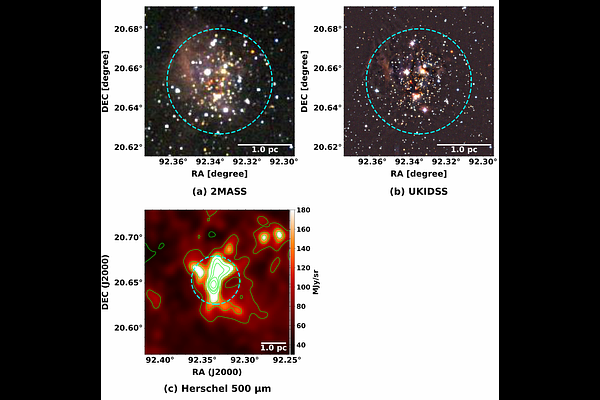Star formation efficiency and scaling relations in parsec-scale cluster-forming clumps

Star formation efficiency and scaling relations in parsec-scale cluster-forming clumps
V. Rawat, M. R. Samal, A. Zavagno, Sami Dib, Davide Elia, J. Jose, D. K. Ojha, K. Srivastav1
AbstractNumerical simulations predict that clumps ($\sim$1 pc) should form stars at high efficiency to produce bound star clusters. We conducted a statistical study of 17 nearby cluster-forming clumps to examine the star formation rate and gas mass surface density relations (i.e. $\Sigma_{\rm{SFR}}$ vs. $\Sigma_{\rm{gas}}$) at the clump scale. Using near-infrared point sources and Herschel dust continuum analysis, we obtained the radius, age, and stellar mass for most clusters in the ranges 0.5$-$1.6 pc, 0.5$-$1.5 Myr, 40$-$500 M$_\odot$, respectively, and also found that they are associated with $\Sigma_{\rm{gas}}$ values ranging from 80$-$600 M$_\odot$ pc$^{-2}$. We obtained the best-fit scaling relations as $\Sigma_{\rm{SFR}}$ $\propto$ $\Sigma_{\rm{gas}}^{1.46}$ and $\Sigma_{\rm{SFR}}$ $\propto$ $(\Sigma_{\rm{gas}}/t_{\rm{ff}})^{0.80}$ for the studied sample of clumps. Comparing our results with existing scaling relations at cloud and extragalactic scales, we found that while the power-law exponent obtained in this work is similar to those found at these scales, the star formation rate surface densities are relatively higher for similar gas mass surface densities. From this work, we obtained instantaneous median star formation efficiency (SFE) and efficiency per free-fall time ($\epsilon_{\rm{ff}}$) of $\sim$20% and $\sim$13%, respectively, for the studied clumps. We discuss the cause of the obtained high SFE and $\epsilon_{\rm{ff}}$ in the studied clumps and also discuss the results in the context of bound cluster formation within molecular clouds. We conclude that our results do not favour a universal scaling law with a constant value of $\epsilon_{\rm{ff}}$ in star-forming systems across different scales.